United States Attorney General
The United States attorney general (AG) is the head of the United States Department of Justice, and is the chief law enforcement officer of the federal government of the United States. The attorney general serves as the principal advisor to the president of the United States on all legal matters. The attorney general is a statutory member of the Cabinet of the United States.
| United States Attorney General | |
|---|---|
 Seal of the Department of Justice | |
 Flag of the United States Attorney General | |
| United States Department of Justice | |
| Style | Mr. Attorney General (informal) The Honorable (formal) |
| Member of | Cabinet National Security Council |
| Reports to | President of the United States |
| Seat | Robert F. Kennedy Department of Justice Building Washington, D.C. |
| Appointer | President of the United States with United States Senate advice and consent |
| Term length | No fixed term |
| Constituting instrument | 28 U.S.C. § 503 |
| Formation | September 26, 1789 |
| First holder | Edmund Randolph |
| Succession | Seventh[1] |
| Deputy | United States Deputy Attorney General |
| Salary | Executive Schedule, Level I[2] |
| Website | www |
Under the Appointments Clause of the United States Constitution, the officeholder is nominated by the president of the United States, then appointed with the advice and consent of the United States Senate. The attorney general is supported by the Office of the Attorney General, which includes executive staff and several deputies.
Merrick Garland has been the United States attorney general since March 11, 2021.[3][4]
History
Congress passed the Judiciary Act of 1789 which, among other things, established the Office of the Attorney General. The original duties of this officer were "to prosecute and conduct all suits in the Supreme Court in which the United States shall be concerned, and to give his advice and opinion upon questions of law when required by the president of the United States, or when requested by the heads of any of the departments".[5] Some of these duties have since been transferred to the United States solicitor general and the White House counsel.
The Department of Justice was established in 1870 to support the attorneys general in the discharge of their responsibilities.
The secretary of state, the secretary of the treasury, the secretary of defense, and the attorney general are regarded as the four most important Cabinet officials in the United States because of the size and importance of their respective departments.[6]
Attorney General is a Level I position in the Executive Schedule,[2] thus earning a salary of US$221,400, as of January 2021.[7]
The title "attorney general" is an example of a noun (attorney) followed by a postpositive adjective (general).[8] "General" is a description of the type of attorney, not a title or rank in itself (as it would be in the military).[8] Even though the attorney general (and the similarly titled solicitor general) is often referred to as "General" or "General [last name]" by senior government officials, this is considered incorrect in standard American English usage.[8][9] For the same reason, the correct American English plural form is "attorneys general" rather than "attorney generals".[9]
Presidential transition
It is the practice for the attorney general, along with the other Cabinet secretaries and high-level political appointees of the President, to tender a resignation with effect on the Inauguration Day (January 20) of a new president. The deputy attorney general is also expected to tender a resignation, but is commonly requested to stay on and act as the attorney general pending the confirmation by the Senate of the new attorney general.
For example, upon the inauguration of President Donald Trump on January 20, 2017, then-Attorney General Loretta Lynch left her position, so then-Deputy Attorney General Sally Yates, who had also tendered her resignation, was asked to stay on to serve as the acting attorney general until the confirmation of the new attorney general Jeff Sessions, who had been nominated for the office in November 2016 by then-President-elect Donald Trump.[10][lower-alpha 1]
List of attorneys general
Parties
Federalist (4) Democratic-Republican (5) Democratic (34) Whig (4) Republican (40) Political Independent (1)
Status
| No. | Portrait | Name | Prior experience | State of residence | Took office | Left office | President(s) | |
|---|---|---|---|---|---|---|---|---|
| 1 |  |
Edmund Randolph | Lawyer,
7th Governor of Virginia |
Virginia | September 26, 1789 | January 26, 1794 | George Washington | |
| 2 |  |
William Bradford | Lawyer, judge,
Attorney General of Pennsylvania |
Pennsylvania | January 27, 1794 | August 23, 1795 | ||
| 3 |  |
Charles Lee | Lawyer, | Virginia | December 10, 1795 | February 19, 1801 | ||
| John Adams | ||||||||
| 4 |  |
Levi Lincoln Sr. | Lawyer,
Acting United States Secretary of State, 7th Lieutenant Governor of Massachusetts, Member of the U.S. House of Representatives from Massachusetts's 4th district |
Massachusetts | March 5, 1801 | March 2, 1805 | Thomas Jefferson | |
| 5 |  |
John Breckinridge | Lawyer,
United States Senator from Kentucky, Speaker of the Kentucky House of Representatives, Attorney General of Kentucky |
Kentucky | August 7, 1805 | December 14, 1806 | ||
| 6 |  |
Caesar Augustus Rodney | Lawyer,
Member of the U.S. House of Representatives from Delaware's at-large district, Member of Delaware General Assembly |
Delaware | January 20, 1807 | December 10, 1811 | ||
| James Madison | ||||||||
| 7 | .jpg.webp) |
William Pinkney | Lawyer,
United States Minister to the United Kingdom, 3rd Attorney General of Maryland, Mayor of Annapolis, Member of the U.S. House of Representatives from Maryland's 3rd district |
Maryland | December 11, 1811 | February 9, 1814 | ||
| 8 | 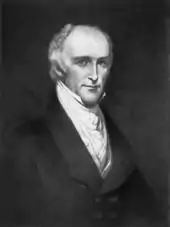 |
Richard Rush | Lawyer,
Attorney General of Pennsylvania |
Pennsylvania | February 10, 1814 | November 12, 1817 | ||
| 9 |  |
William Wirt | Lawyer,
United States Attorney for the District of Virginia, Member of the Virginia House of Delegates from Richmond City 6th Clerk of the Virginia House of Delegates |
Virginia | November 13, 1817 | March 4, 1829 | James Monroe | |
| John Quincy Adams | ||||||||
| 10 |  |
John Macpherson Berrien | Lawyer,
Judge of the Eastern judicial circuit of Georgia, |
Georgia | March 9, 1829 | July 19, 1831 | Andrew Jackson | |
| 11 | 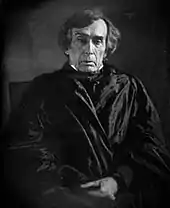 |
Roger B. Taney | Lawyer,
Acting United States Secretary of War, Attorney General of Maryland |
Maryland | July 20, 1831 | November 14, 1833 | ||
| 12 |  |
Benjamin Franklin Butler | Lawyer,
Member of the New York State Assembly from Albany County, District Attorney of Albany County |
New York | November 15, 1833 | July 4, 1838 | ||
| Martin Van Buren | ||||||||
| 13 |  |
Felix Grundy | Lawyer,
United States Senator from Tennessee, Member of the U.S. House of Representatives from Tennessee's 3rd district and 5th district, Chief Justice of the Kentucky Court of Appeals |
Tennessee | July 5, 1838 | January 10, 1840 | ||
| 14 | .jpg.webp) |
Henry D. Gilpin | Lawyer,
Solicitor of the United States Treasury, U.S. Attorney for the Eastern District of Pennsylvania |
Pennsylvania | January 11, 1840 | March 4, 1841 | ||
| 15 | 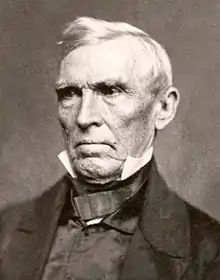 |
John J. Crittenden 1st term |
Lawyer,
22nd Secretary of State of Kentucky, |
Kentucky | March 5, 1841 | September 12, 1841 | William Henry Harrison | |
| John Tyler | ||||||||
| 16 |  |
Hugh S. Legaré | Lawyer,
Member of the U.S. House of Representatives from South Carolina's 1st district Acting United States Minister to Belgium, 7th Attorney General of South Carolina |
South Carolina | September 13, 1841 | June 20, 1843 | ||
| 17 |  |
John Nelson | Lawyer,
United States Chargé d'Affaires to the Kingdom of the Two Sicilies, Member of the U.S. House of Representatives from Maryland's 4th district |
Maryland | July 1, 1843 | March 4, 1845 | ||
| 18 |  |
John Y. Mason | Lawyer,
16th United States Secretary of the Navy Judge of the United States District Court for the Eastern District of Virginia, Member of the U.S. House of Representatives from Virginia's 2nd district |
Virginia | March 5, 1845 | October 16, 1846 | James K. Polk | |
| 19 | 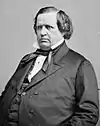 |
Nathan Clifford | Lawyer,
Member of the U.S. House of Representatives from Maine's 1st district, Attorney General of Maine, Member of the Maine House of Representatives, |
Maine | October 17, 1846 | March 17, 1848 | ||
| 20 |  |
Isaac Toucey | Lawyer,
33rd Governor of Connecticut, Member of the U.S. House of Representatives from Connecticut's at-large district and 1st district |
Connecticut | June 21, 1848 | March 4, 1849 | ||
| 21 |  |
Reverdy Johnson | Lawyer, | Maryland | March 8, 1849 | July 21, 1850 | Zachary Taylor | |
| 22 |  |
John J. Crittenden 2nd term |
Lawyer,
15th United States Attorney General 22nd Secretary of State of Kentucky, |
Kentucky | July 22, 1850 | March 4, 1853 | Millard Fillmore | |
| 23 |  |
Caleb Cushing | Lawyer,
United States Minister to China, Member of the U.S. House of Representatives from Massachusetts's 3rd district |
Massachusetts | March 7, 1853 | March 4, 1857 | Franklin Pierce | |
| 24 |  |
Jeremiah S. Black | Lawyer,
Justice of the Pennsylvania Supreme Court |
Pennsylvania | March 6, 1857 | December 16, 1860 | James Buchanan | |
| 25 | 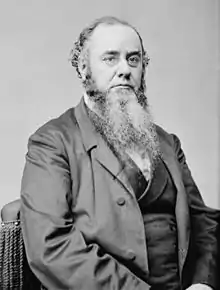 |
Edwin Stanton | Lawyer | Pennsylvania | December 20, 1860 | March 4, 1861 | ||
| 26 |  |
Edward Bates | Lawyer,
Member of the U.S. House of Representatives from Missouri's at-large district, Attorney General of Missouri |
Missouri | March 5, 1861 | November 24, 1864 | Abraham Lincoln | |
| 27 |  |
James Speed | Lawyer,
Member of the Kentucky House of Representatives |
Kentucky | December 2, 1864 | July 22, 1866 | ||
| Andrew Johnson | ||||||||
| 28 |  |
Henry Stanbery | Lawyer,
Attorney General of Ohio |
Ohio | July 23, 1866 | July 16, 1868 | ||
| 29 |  |
William M. Evarts | Lawyer | New York | July 17, 1868 | March 4, 1869 | ||
| 30 |  |
Ebenezer R. Hoar | Lawyer, judge | Massachusetts | March 5, 1869 | November 22, 1870 | Ulysses S. Grant | |
| 31 | 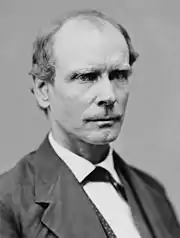 |
Amos T. Akerman | Lawyer, teacher | Georgia | November 23, 1870 | December 13, 1871 | ||
| 32 |  |
George Henry Williams | United States Senator from Oregon
3rd Chief Justice of Oregon Supreme Court |
Oregon | December 14, 1871 | April 25, 1875 | ||
| 33 |  |
Edwards Pierrepont | Attorney
U.S. Attorney's Office for the Southern District of New York |
New York | April 26, 1875 | May 21, 1876 | ||
| 34 |  |
Alphonso Taft | 31st United States Secretary of War | Ohio | May 22, 1876 | March 4, 1877 | ||
| 35 |  |
Charles Devens | Massachusetts | March 12, 1877 | March 4, 1881 | Rutherford B. Hayes | ||
| 36 |  |
Wayne MacVeagh | Lawyer,
United States Ambassador to the Ottoman Empire |
Pennsylvania | March 5, 1881 | December 15, 1881 | James A. Garfield | |
| Chester A. Arthur | ||||||||
| 37 |  |
Benjamin H. Brewster | Attorney General of Pennsylvania | Pennsylvania | December 16, 1881 | March 4, 1885 | ||
| 38 |  |
Augustus Garland | Lawyer,
United States Senator from Arkansas, 11th Governor of Arkansas |
Arkansas | March 6, 1885 | March 4, 1889 | Grover Cleveland | |
| 39 |  |
William H. H. Miller | Lawyer | Indiana | March 7, 1889 | March 4, 1893 | Benjamin Harrison | |
| 40 |  |
Richard Olney | Lawyer | Massachusetts | March 6, 1893 | April 7, 1895 | Grover Cleveland | |
| 41 |  |
Judson Harmon | Lawyer | Ohio | April 8, 1895 | March 4, 1897 | ||
| 42 |  |
Joseph McKenna | Judge of the United States Court of Appeals for the Ninth Circuit,
Member of the U.S. House of Representatives from California's 3rd district |
California | March 5, 1897 | January 25, 1898 | William McKinley | |
| 43 |  |
John W. Griggs | Lawyer,
28th Governor of New Jersey |
New Jersey | January 25, 1898 | March 29, 1901 | ||
| 44 |  |
Philander C. Knox | Lawyer,
Assistant United States Attorney for the Western District of Pennsylvania (1876–1877), President of the Pennsylvania Bar Association |
Pennsylvania | April 5, 1901 | June 30, 1904 | ||
| Theodore Roosevelt | ||||||||
| 45 |  |
William Henry Moody | 35th United States Secretary of the Navy,
Member of the U.S. House of Representatives from Massachusetts's 6th district |
Massachusetts | July 1, 1904 | December 17, 1906 | ||
| 46 |  |
Charles Bonaparte | Lawyer, | Maryland | December 17, 1906 | March 4, 1909 | ||
| 47 |  |
George W. Wickersham | Lawyer | New York | March 4, 1909 | March 4, 1913 | William Howard Taft | |
| 48 | 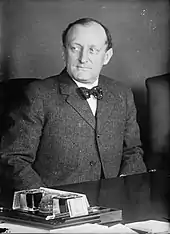 |
James C. McReynolds | Lawyer | Tennessee | March 5, 1913 | August 29, 1914 | Woodrow Wilson | |
| 49 |  |
Thomas Watt Gregory | Lawyer | Texas | August 29, 1914 | March 4, 1919 | ||
| 50 |  |
A. Mitchell Palmer | Attorney,
Member of the U.S. House of Representatives from Pennsylvania's 26th district |
Pennsylvania | March 5, 1919 | March 4, 1921 | ||
| 51 |  |
Harry M. Daugherty | Lawyer
Member of the Ohio House of Representatives (1889−1893) Republican Political Operative from Ohio |
Ohio | March 4, 1921 | April 6, 1924 | Warren G. Harding | |
| Calvin Coolidge | ||||||||
| 52 | 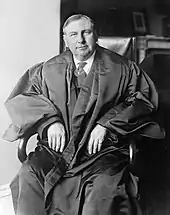 |
Harlan F. Stone | Lawyer | New York | April 7, 1924 | March 1, 1925 | ||
| 53 |  |
John G. Sargent | Lawyer,
Attorney General of Vermont |
Vermont | March 7, 1925 | March 4, 1929 | ||
| 54 |  |
William D. Mitchell | Attorney,
18th United States Solicitor General |
Minnesota | March 4, 1929 | March 4, 1933 | Herbert Hoover | |
| 55 | 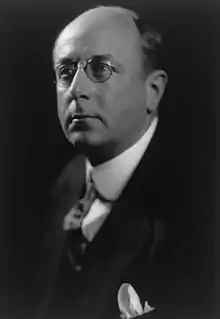 |
Homer Stille Cummings | Mayor of Stamford, Connecticut (1904-1906),State Attorney of Fairfield County (1914-1924),
Chair of the Democratic National Committee (1919-1920) |
Connecticut | March 4, 1933 | January 1, 1939 | Franklin D. Roosevelt | |
| 56 |  |
Frank Murphy | Governor-General of the Philippines (1933-1935),
1st High Commissioner to the Philippines (1935-1936), 35th Governor of Michigan (1937-1939) |
Michigan | January 2, 1939 | January 18, 1940 | ||
| 57 |  |
Robert H. Jackson | Lawyer,
United States Assistant Attorney General for the Tax Division (1936-1937), United States Assistant Attorney General for the Antitrust Division (1937-1938), 24th United States Solicitor General (1938-1940) |
New York | January 18, 1940 | August 25, 1941 | ||
| 58 |  |
Francis Biddle | Pennsylvania | August 26, 1941 | June 26, 1945 | |||
| Lawyer,
Deputy Chair of the Board of Directors of the Federal Reserve Bank of Pennsylvania (1938-1939), Judge of the United States Court of Appeals for the Third Circuit (1939-1940), 25th United States Solicitor General (1940-1941) |
Harry S. Truman | |||||||
| 59 |  |
Tom C. Clark | Lawyer,
United States Assistant Attorney General for the Criminal Division (1943-1945) |
Texas | June 27, 1945 | July 26, 1949 | ||
| 60 |  |
J. Howard McGrath | Lawyer,
60th Governor of Rhode Island (1941-1945), 27th United States Solicitor General (1945-1946), Chair of the Democratic National Committee (1947-1949), United States Senator from Rhode Island (1947-1949) |
Rhode Island | July 27, 1949 | April 3, 1952 | ||
| 61 |  |
James P. McGranery | Member of the U.S. House of Representatives from Pennsylvania's 2nd district (1937-1943),
Judge of the United States District Court for the Eastern District of Pennsylvania (1946-1952) |
Pennsylvania | April 4, 1952 | January 20, 1953 | ||
| 62 |  |
Herbert Brownell Jr. | Member of the New York State Assembly from the 10th district (1933-1937),
Chair of the Republican National Committee (1944-1946) |
New York | January 21, 1953 | October 23, 1957 | Dwight D. Eisenhower | |
| 63 |  |
William P. Rogers | Attorney,
4th United States Deputy Attorney General (1953-1957) |
New York | October 23, 1957 | January 20, 1961 | ||
| 64 |  |
Robert F. Kennedy | Lawyer | Massachusetts | January 20, 1961 | September 3, 1964 | John F. Kennedy | |
| Lyndon B. Johnson | ||||||||
| 65 |  |
Nicholas Katzenbach | Illinois | September 4, 1964[lower-alpha 2] | January 28, 1965 | |||
| Lawyer,
7th United States Deputy Attorney General (1962-1965) |
January 28, 1965 | November 28, 1966 | ||||||
| 66 |  |
Ramsey Clark | Texas | November 28, 1966[lower-alpha 2] | March 10, 1967 | |||
| United States Assistant Attorney General for the Environment and Natural Resources Division (1961-1965),
8th United States Deputy Attorney General (1965-1967) |
March 10, 1967 | January 20, 1969 | ||||||
| 67 |  |
John N. Mitchell | Lawyer | New York | January 20, 1969 | February 15, 1972 | Richard Nixon | |
| 68 |  |
Richard Kleindienst | Lawyer,
10th United States Deputy Attorney General (1969-1972) |
Arizona | February 15, 1972 | April 30, 1973[12] | ||
| 69 | 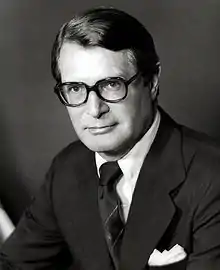 |
Elliot Richardson | Lawyer,
37th Attorney General of Massachusetts (1967-1969), 25th United States Under Secretary of State (1969-1970), 9th United States Secretary of Health, Education, and Welfare (1970-1973), 11th United States Secretary of Defense (Jan-May 1973) |
Massachusetts | May 25, 1973[12] | October 20, 1973 | ||
| – |  |
Robert Bork[lower-alpha 3] Acting |
Pennsylvania | October 20, 1973 | January 4, 1974 | |||
| 70 |  |
William B. Saxbe | U.S. Senator from Ohio | Ohio | January 4, 1974 | February 2, 1975 | ||
| Speaker of the Ohio House of Representatives (1953-1955),
Ohio Attorney General (1957-1959; 1963-1969), United States Senator from Ohio (1969-1974) |
Gerald Ford | |||||||
| 71 |  |
Edward H. Levi | Illinois | February 2, 1975 | January 20, 1977 | |||
| – |  |
Dick Thornburgh[lower-alpha 4] Acting |
Pennsylvania | January 20, 1977 | January 26, 1977 | Jimmy Carter | ||
| 72 |  |
Griffin Bell | Georgia | January 26, 1977 | August 16, 1979 | |||
| 73 | .jpg.webp) |
Benjamin Civiletti | Maryland | August 16, 1979 | January 19, 1981 | |||
| 74 |  |
William French Smith | California | January 23, 1981 | February 25, 1985 | Ronald Reagan | ||
| 75 | .jpg.webp) |
Edwin Meese | California | February 25, 1985 | August 12, 1988 | |||
| 76 |  |
Dick Thornburgh |
Acting United States Attorney General (1977) Governor of Pennsylvania (1979–1987) |
Pennsylvania | August 12, 1988 | August 15, 1991 | ||
| George H. W. Bush | ||||||||
| 77 |  |
William Barr 1st term |
United States Deputy Attorney General (1990–1991)
United States Assistant Attorney General for the Office of Legal Counsel (1989–1990) |
Virginia | August 16, 1991[lower-alpha 2] | November 26, 1991 | ||
| November 26, 1991 | January 20, 1993 | |||||||
| – |  |
Stuart M. Gerson[lower-alpha 5] Acting |
Washington, D.C. | January 20, 1993 | March 12, 1993 | Bill Clinton | ||
| 78 | 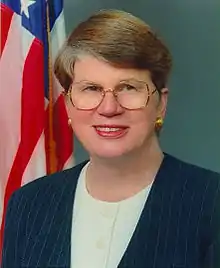 |
Janet Reno | Florida | March 12, 1993 | January 20, 2001 | |||
| – |  |
Eric Holder[lower-alpha 6] Acting |
United States Deputy Attorney General (1997–2001)
United States Attorney for the District of Columbia (1993–1997) Judge of the Superior Court of the District of Columbia (1988–1993) |
Washington, D.C. | January 20, 2001 | February 2, 2001 | George W. Bush | |
| 79 | 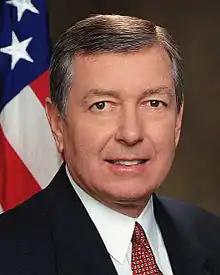 |
John Ashcroft | Missouri | February 2, 2001 | February 3, 2005 | |||
| 80 |  |
Alberto Gonzales | Texas | February 3, 2005 | September 17, 2007 | |||
| – |  |
Paul Clement[lower-alpha 7] Acting |
Washington, D.C. | September 17, 2007 | September 18, 2007 | |||
| – |  |
Peter Keisler[lower-alpha 7] Acting |
Washington, D.C. | September 18, 2007 | November 9, 2007 | |||
| 81 |  |
Michael Mukasey | New York | November 9, 2007 | January 20, 2009 | |||
| – |  |
Mark Filip Acting |
Illinois | January 20, 2009 | February 3, 2009 | Barack Obama | ||
| 82 | .jpg.webp) |
Eric Holder | Acting United States Attorney General (2001)
United States Deputy Attorney General (1997–2001) United States Attorney for the District of Columbia (1993–1997) Judge of the Superior Court of the District of Columbia (1988–1993) |
Washington, D.C. | February 3, 2009 | April 27, 2015 | ||
| 83 | .jpg.webp) |
Loretta Lynch | United States Attorney for the Eastern District of New York (1999–2001, 2010–2015)
Member of the Board of the Federal Reserve Bank of New York (2003–2005) |
New York | April 27, 2015 | January 20, 2017 | ||
| – | .jpg.webp) |
Sally Yates[lower-alpha 8] Acting |
Georgia | January 20, 2017 | January 30, 2017 | Donald Trump | ||
| – | .jpg.webp) |
Dana Boente Acting |
Virginia | January 30, 2017 | February 9, 2017 | |||
| 84 | .jpg.webp) |
Jeff Sessions | United States Senator from Alabama (1997–2017)
Attorney General of Alabama (1995–1997) United States Attorney for the Southern District of Alabama (1981–1993) |
Alabama | February 9, 2017 | November 7, 2018 | ||
| – | .jpg.webp) |
Matthew Whitaker Acting[lower-alpha 9] |
Iowa | November 7, 2018 | February 14, 2019 | |||
| 85 | .jpg.webp) |
William Barr 2nd term |
77th United States Attorney General (1991–1993)
United States Deputy Attorney General (1990–1991) United States Assistant Attorney General for the Office of Legal Counsel (1989–1990) |
Virginia | February 14, 2019 | December 23, 2020 | ||
| – | .jpg.webp) |
Jeffrey A. Rosen Acting |
Massachusetts | December 24, 2020 | January 20, 2021 | |||
| – |  |
Monty Wilkinson Acting |
Washington, D.C. | January 20, 2021 | March 11, 2021 | Joe Biden | ||
| 86 | 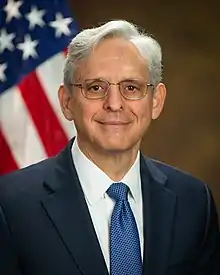 |
Merrick Garland | Chief Judge of the United States Court of Appeals for the District of Columbia Circuit (2013–2020)
Nominee for Associate Justice of the Supreme Court (2016) Judge of the United States Court of Appeals for the District of Columbia Circuit (1997–2021) |
Maryland | March 11, 2021 | Incumbent | ||
Living former U.S. attorneys general
As of November 2022, there are eight living former U.S. attorneys general, the oldest being Edwin Meese (served 1985–1988, born 1931). The most recent attorney general to die was Benjamin Civiletti on October 16, 2022 (served 1979–1981, born 1935). The most recently serving attorney general to die was Janet Reno on November 7, 2016 (served 1993–2001, born 1938).
| Name | Commencement | Conclusion | Date of birth (and age) |
|---|---|---|---|
| Edwin Meese | 1985 | 1988 | December 2, 1931 |
| William Barr | 1991 2019 |
1993 2020 |
May 23, 1950 |
| John Ashcroft | 2001 | 2005 | May 9, 1942 |
| Alberto Gonzales | 2005 | 2007 | August 4, 1955 |
| Michael Mukasey | 2007 | 2009 | July 28, 1941 |
| Eric Holder | 2009 | 2015 | January 21, 1951 |
| Loretta Lynch | 2015 | 2017 | May 21, 1959 |
| Jeff Sessions | 2017 | 2018 | December 24, 1946 |
Line of succession
U.S.C. Title 28, §508 establishes the first two positions in the line of succession, while allowing the attorney general to designate other high-ranking officers of the Department of Justice as subsequent successors.[25] Furthermore, an Executive Order defines subsequent positions, the most recent from March 31, 2017, signed by President Donald Trump.[26] The current line of succession is:
- United States Deputy Attorney General
- United States Associate Attorney General
- Other officers potentially designated by the attorney general (in no particular order):
- Solicitor General of the United States
- Assistant Attorney General, Antitrust Division
- Assistant Attorney General, Civil Division
- Assistant Attorney General, Civil Rights Division
- Assistant Attorney General, Criminal Division
- Assistant Attorney General, National Security Division
- Assistant Attorney General, Environment and Natural Resources Division
- Assistant Attorney General, Justice Management Division
- Assistant Attorney General, Tax Division
- Assistant Attorney General, Office of Justice Programs
- Assistant Attorney General, Office of Legal Counsel
- Assistant Attorney General, Office of Legal Policy
- Assistant Attorney General, Office of Legislative Affairs
- United States Attorney for the Eastern District of Virginia
- United States Attorney for the Eastern District of North Carolina
- United States Attorney for the Northern District of Texas
See also
- Executive Order 13787 for "Providing an Order of Succession Within the Department of Justice"
Notes
- Unusually for a transitional acting appointment, Yates was dismissed and replaced with another Acting Attorney General before Sessions was confirmed because she refused to defend an executive order of the incoming administration.[11]
- Served as acting attorney general in his capacity as deputy attorney general, until his own appointment and confirmation as attorney general.
- On October 20, 1973, Solicitor General Robert Bork became acting attorney general following the "Saturday Night Massacre", in which U.S. Attorney General Elliot Richardson and Deputy Attorney General William Ruckelshaus both resigned.
- Served as acting attorney general in his capacity as deputy attorney general, until the appointment of a new attorney general. Thornburgh later served as attorney general from 1988–1991.
- Served as acting attorney general in his capacity as Assistant Attorney General for the DOJ Civil Division.[13] Gerson was fourth in the line of succession at the Justice Department, but other senior DOJ officials had already resigned.[14] Janet Reno, President Clinton's nominee for attorney general, was confirmed on March 12,[15] and he resigned the same day.[15]
- Served as acting attorney general in his capacity as deputy attorney general, until the appointment of a new attorney general. Holder later served as attorney general from 2009–2015.
- On August 27, 2007, President Bush named Solicitor General Paul Clement as the future acting attorney general, to take office upon the resignation of Alberto Gonzales, effective September 17, 2007.[16] On September 17, President Bush announced that Assistant Attorney General for the DOJ Civil Division Peter Keisler would become acting attorney general, pending a permanent appointment of a presidential nominee.[17][18] According to administration officials, Clement became acting attorney general at 12:01 am September 17, 2007, and left office 24 hours later.[19] Keisler served as acting attorney general until the confirmation of Michael Mukasey on November 9, 2007.
- Served as acting attorney general in her capacity as deputy attorney general, until she was fired after saying the Department of Justice would not defend an executive order in court.[20]
- The legality of Matthew Whitaker's appointment as Acting Attorney General was called into question by several constitutional scholars. Among those included Neal Katyal and George T. Conway III, who asserted it is unconstitutional, because the Attorney General is a principal officer under the Appointments Clause, and thus requires senate consent, even in an acting capacity.[21] Maryland filed an injunction against Whitaker's appointment on this basis.[22] John E. Bies at Lawfare regarded it as an unresolved question.[23] The DOJ Office of Legal Counsel released a legal opinion, asserting that the appointment was legal and consistent with past precedent.[24]
References
- "3 U.S. Code § 19 – Vacancy in offices of both President and Vice President; officers eligible to act". Retrieved November 7, 2018.
- 5 U.S.C. § 5312.
- Benner, Katie (March 10, 2021). "Merrick Garland Is Confirmed as Attorney General". The New York Times. Archived from the original on December 28, 2021.
- Twitter https://twitter.com/thejusticedept/status/1370023440904716291. Retrieved March 11, 2021.
{{cite web}}: Missing or empty|title=(help) - Judiciary Act of 1789, section 35.
- Cabinets and Counselors: The President and the Executive Branch (1997). Congressional Quarterly. p. 87.
- "Salary Table No. 2021-EX Rates of Basic Pay for the Executive Schedule (EX)" (PDF).
- Herz, Michael (2002). "Washington, Patton, Schwarzkopf and ... Ashcroft?". Constitutional Commentary.
- Garner, Bryan A. "LawProse Lesson #116: What's the plural form of attorney general? And what is the plural possessive?". Above the Law. Retrieved May 31, 2019.
- Gerstein, Josh (January 17, 2017). "Trump will allow U.S. attorneys to stay past Friday". POLITICO. Retrieved July 25, 2019.
- Horwitz, Sari (January 30, 2017). "Who is Sally Yates? Meet the acting attorney general Trump fired for 'betraying' the Justice Department". Washington Post. Retrieved July 25, 2019.
- Stern, Laurence; Johnson, Haynes (May 1, 1973). "3 Top Nixon Aides, Kleindienst Out; President Accepts Full Responsibility; Richardson Will Conduct New Probe". The Washington Post. Retrieved February 28, 2019.
- Staff reporter (February 21, 1993). "Stuart Gerson's Parting Shot". The New York Times. Retrieved December 12, 2008.
As supporters of the Brady gun-control bill prepare to introduce it in Congress yet again this week, they find a welcome, if unlikely, ally in Stuart Gerson, the Acting Attorney General. Because President Clinton has had so many problems finding a new Attorney General, Mr. Gerson remains in office ...
- Labaton, Stephen (January 25, 1993). "Notes on Justice; Who's in Charge? Bush Holdover Says He Is, but Two Clinton Men Differ". The New York Times. Retrieved December 12, 2008.
- Ifill, Gwen (March 12, 1993). "Reno Confirmed in Top Justice Job". The New York Times. Retrieved December 12, 2008.
She will replace Acting Attorney General Stuart M. Gerson, a holdover appointee from the Bush Administration. Ms. Reno said he resigned today.
- Meyers, Steven Lee (August 27, 2007). "Embattled Attorney General Resigns". The New York Times. Retrieved August 27, 2007.
- "President Bush Announces Judge Michael Mukasey as Nominee for Attorney General", White House press release, September 17, 2007
- "Bush Text on Attorney General Nomination". NewsOK.com. The Oklahoman. The Associated Press. September 17, 2007. Retrieved September 18, 2007.
- Eggen, Dan; Elizabeth Williamson (September 19, 2007). "Democrats May Tie Confirmation to Gonzales Papers". The Washington Post. pp. A10. Retrieved September 19, 2007.
- Perez, Evan; Diamond, Jeremy (January 30, 2017). "Trump fires acting AG after she declines to defend travel ban". CNN. Retrieved March 12, 2018.
- "Opinion | Trump's Appointment of the Acting Attorney General Is Unconstitutional". Retrieved November 15, 2018.
- "Maryland Says Matthew Whitaker Appointment As Acting Attorney General Is Unlawful". NPR.org. Retrieved November 15, 2018.
- "Matthew Whitaker's Appointment as Acting Attorney General: Three Lingering Questions". Lawfare. November 8, 2018. Retrieved November 15, 2018.
- Jarrett, Laura. "DOJ says Whitaker's appointment as acting attorney general is constitutional". CNN. Retrieved November 15, 2018.
- "U.S.C. Title 28 – JUDICIARY AND JUDICIAL PROCEDURE". www.gpo.gov. Retrieved June 14, 2018.
- "Providing an Order of Succession Within the Department of Justice". Federal Register. April 5, 2017. Retrieved June 14, 2018.
.svg.png.webp)